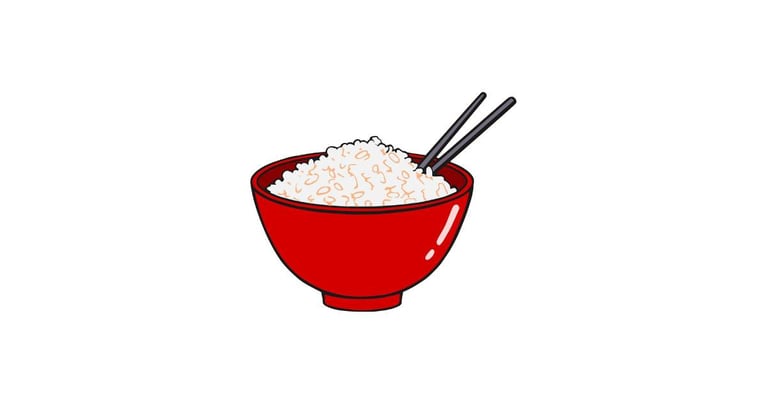11 Facts About Rice
Explore 11 amazing facts about rice, from its ancient beginnings to its everyday surprises. Find out why this understated grain dominates plates worldwide.
FACTS ABOUT


a bowl of rice (credit: pixabay)
Except when it ends up as remnants or attached to the bottom of your takeaway package, rice does not receive a lot of focus. However, my fascination as well as small obsession with this common grain grew as I learned more regarding it. Over half of the world's population continues to consume one of the oldest meals on a daily basis. The majority of us, however, understand very little regarding it other than ways to cook it and whether it is brown or white. Consequently, I took an alternative route. Not only was what I discovered unexpected, but it also caused me to re-evaluate my perspective on something as basic as a bowl of rice. These are 11 facts you have to understand but unlikely failed to do so.
Rice is The Most Consumed Food: Each day, more than 3.5 billion people consume rice. That is greater than the total population of Europe and the Americas. It is the foundation of meals in many civilizations, from West African jollof rice to Japanese sushi. It is the most popular essential meal on the entire globe because of its affordability, extended shelf life, and flexibility.
Rice Was Domesticated Over 9,000 Years Ago: Individuals in the Yangtze River Valley of China were growing rice earlier than pizza or pasta were even a thing. Based on historical records, rice was domesticated approximately 9,400 years back. Rice is therefore more elderly than wheat, corn, as well as potatoes, making it one of the earliest crops continuing to be farmed extensively presently.
Rice Can Grow in Both Wet & Dry Conditions: When we visualize rice farming, we frequently envision flooded paddy fields, which is a typical occurrence in Asia. However, rice is very versatile. Substitute watering and drying is a technique used by farmers in areas that are dryer to conserve water without sacrificing production. Sustainable agriculture is undergoing an unexpected transformation.
Rice Black in Colour Was Once Called 'Forbidden Rice': Black rice, sometimes known as "forbidden rice," got the title since it was formerly only fed to Chinese rulers. Packed with fiber, antioxidants, and a nutty flavour, it was so precious that it was prohibited for the general public from consuming it. It is presently a little more expensive, but luckily easier to acquire now.
Rice Golden in Colour is Genetically Modified For Nutrition: Golden rice is a vibrant yellow grain that was created to help people in Asia and Africa who are vitamin A deficient, particularly youngsters. It has undergone genetic modification in order to yield beta-carotene, which gives carrots their orange colour and assists in preventing blindness. It could save millions of individuals, while being unpopular in some areas.
Rice Can Be Used to Make Biofuel: Who would have thought that your food could light up your house at some point? Straw and rice husks, which are harvest byproducts, are turned into biofuel in many Asian countries. It is a cost-effective and sustainable energy source, particularly for remote regions that have minimal accessibility to power.
Rice Has Been Used as Currency: I was blown away by this particular one. In several regions of ancient Asia, rice was used to pay taxes and wages. It was more than simply nourishment; it was financial stability. That demonstrates how important it was to communities whose continued existence was frequently reliant on crop production.
Rice Can Absorb Radioactive Elements: Scientists kept a careful eye on rice cultivation in nearby regions of the Fukushima accident in Japan. The reason being that the radioactive element cesium-137 can be absorbed by rice plants. Soil testing and crop monitoring are therefore essential in the surrounding area of nuclear-affected areas. Food safety precautions are therefore more important than before.
Rice Has Been Grown in Space: Yes, you read correctly. To observe how rice seeds respond to cosmic radiation and zero gravity, Chinese scientists successfully launched the seeds into space. The objective? to develop new rice species that are more resilient to health issues, dry weather, and other harsh environmental factors. Talk about extraordinary agriculture.
Rice is Naturally Gluten-Free: Rice is your buddy if you suffer from celiac disease or are gluten sensitive. It is one of the healthiest grains for those with particular dietary needs because it contains no gluten at all. Always watch out for undeclared gluten in processed or pre-seasoned rice combinations.
Rice Water is Used in Skincare: Rice water existed prior to pricey serums and K-beauty treatments. Asian women have been treating their skin and hair with the starchy water that remains after boiling or rinsing rice for ages. It is supposed to promote flawless skin and stronger hair because it is high in antioxidants and amino acids. Someone I personally know has used it. It is easy, affordable, and remarkably successful.
Summary: Rice is Not Only a Side Dish
I believe that this has convinced you to reconsider rice's reputation as "just a supplement." I definitely have an alternate point of view today. Rice, whether it is floating through space, powering communities, or saving individuals through nourishment, is gradually accomplishing considerably more than we understand. Take a moment the following time you are putting a portion on your plate. Not only are you consuming food, but you are also contributing to a tradition that dates back thousands of years and keeps influencing societies, economies, and health all around the world.
